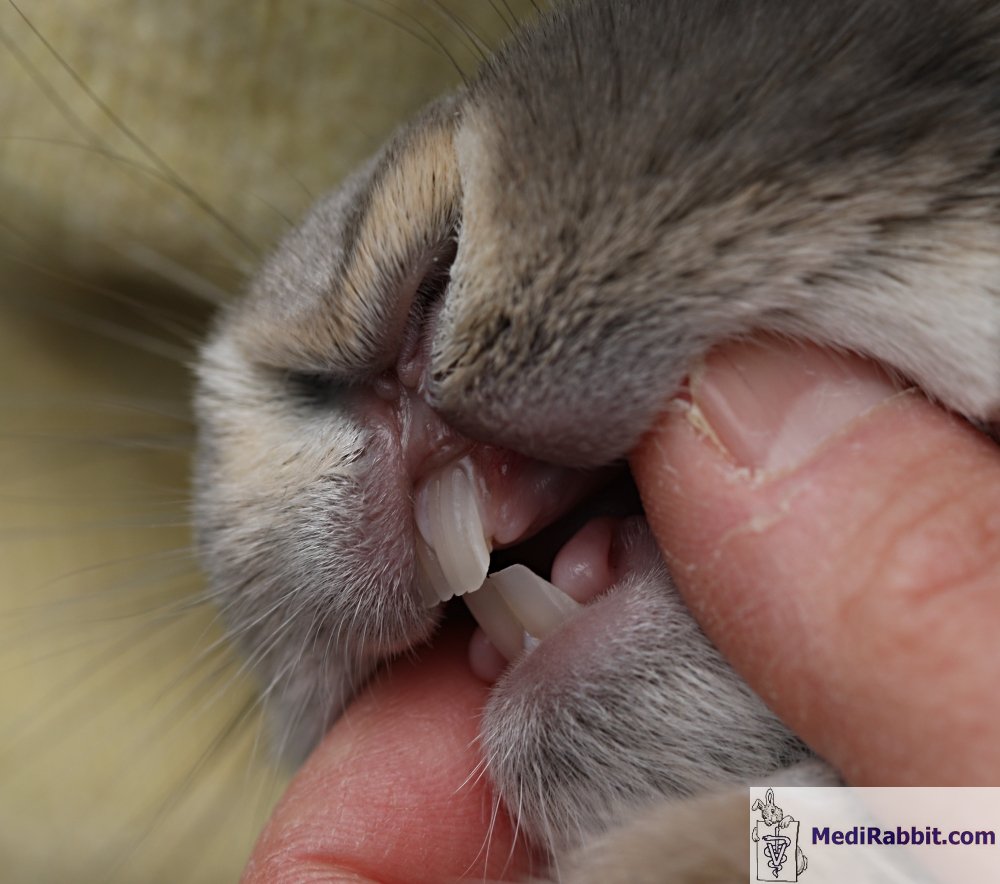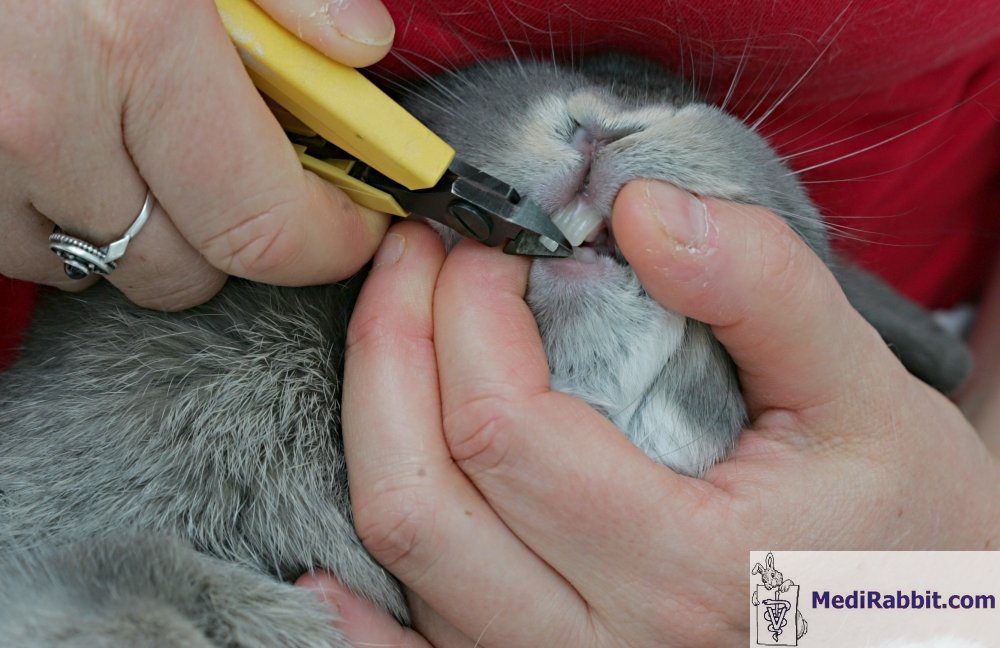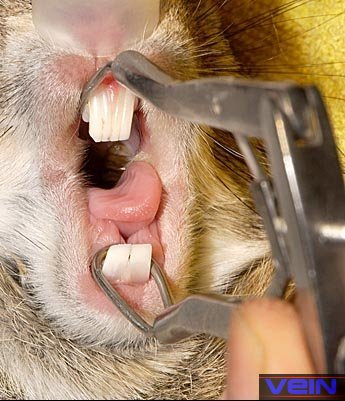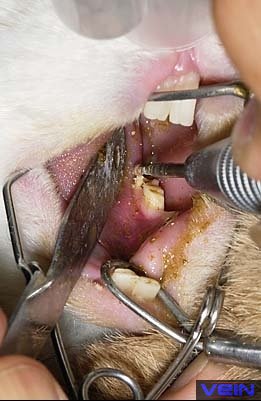Never
trim the incisors of your rabbit yourself !!!
|
MediRabbit.com is funded solely by the generosity of
donors. Every donation, no matter what the
size, is appreciated and will aid in the continuing research of medical care
and health of rabbits.
Thank
you |
In a healthy occlusion, the
top incisors should overlap the bottom incisors slightly. The bottom incisors
should rest between the first and second pair of upper incisors. The second
pair is located right behind the upper incisors. Clinical
presentations of different rabbit dental disorders
Never use a pair of small wire cutters or nail clippers to trim
your rabbit's overgrown Incisors !!! It is painful and unpleasant, and
will sooner or later lead to serious dental problems!!! Using a rotary tool (e.g. a Dremel) for the self-treatment
of incisors is also dangerous without proper training or precise instruction
from a veterinary professional. How can you safely restrain a rabbit, open
its mouth, file its incisors, ensure that the tooth temperature does not
become too high, see how much filing has been done and avoid touching or
damaging the tongue? What about pain relief? Trancing is not an effective way to keep the rabbit calm.
It may wake up unexpectedly and try to fight or escape while its incisors are
being trimmed with a Dremel tool. It's better not to imagine the
consequences! These pictures were taken for illustration purposes only and
were reworked in the computer (Photos:
A.
van Praag). Self-trimming a rabbit's incisors can cause tremendous
distress and pain. Inevitably, self-trimming a rabbit's teeth has disastrous
consequences. Dental problems frequently observed as a
result of self-trimming with a cutter or nail clipper include: ·
Sharp edges that could hurt the rabbit when it is eating
or grooming itself; ·
Stress fractures or longitudinal cracks in the tooth,
either in the visible part or under the gum line; ·
Tooth growth can stop growing due to damage of the tooth
root (endodontic diseases); ·
Exposure of the dental pulp which can result in pulpitis
(inflammation of the innermost part of a tooth); ·
Abscessation and changes to the surrounding tissues and
the alveolar bone. ·
Fracture of the jaw bone; ·
Pain due to the sudden concussion of the dental pulp and
nerves in the periodontal and periapical tissues surrounding the tooth root,
due to the large amount of energy released into the tooth during the
clipping. If malocclusion of the incisors is present, regular
self-trimming will often worsen the alignment, resulting in the need for
drastic dental work when professional help is finally sought. In some cases,
the problem may be so severe that euthanasia is the only option. Correction of dental disorders should be done
by an experienced veterinarian only If dental disease is suspected or observed, an oral
examination of a conscious rabbit should be accompanied by a general
examination, an examination of the oral cavity under full
The oral cavity of the rabbit is small, and the jaws have
limited mobility. This complicates the examination of the oral cavity with an
otoscope on a conscious rabbit. Dental problems or lesions can easily be
overlooked. A full evaluation of dental problems and their treatment (e.g.
trimming of incisors, coronal reduction) is only possible on an anaesthetised
rabbit, using proper instruments such as incisor gags, cheek pouch retractors
or a table-top gag. If a rabbit is allergic to an anaesthetic drug or
anaesthesia is not a viable option due to health concerns, trimming of
overgrown incisors can be performed on a conscious but sedated rabbit. Incisors and molars, on the other hand, have a high growth
rate, about 11-12 cm a year throughout a rabbit's lifetime. It should be
noted that the trimming of abnormally growing incisors may be required at
four- to six-week intervals, and occasionally even three-week intervals.
Surgical removal of the incisors may be an option to avoid regular visits to
the veterinarian, more so to avoid the onset of soft tissue damage, abscesses
and/or secondary problems like dacryocystitis and blockage of the sinuous nasolacrimal
duct. In most cases, the tooth will not regrow after it has been removed. In exceptional circumstances, a
veterinarian may provide guidance to the owner on how to manage the incisors
in cases where a rabbit is experiencing severe dental problems and regular
trimming or surgical removal is not feasible. It is imperative that this
situation remains an exception. |
|||||||||||||||||||
_____________________________________________________________
I would
like to express my gratitude to Kim Chilson for sharing the story and pictures
of her beloved Georgie rabbit.
I would
also like to thank Dr. C. Morales and Debbie Hanson for providing pictures of
malocclusion from Stella.
My
rabbit Kaspi is also to be commended for his help and demonstration of
dangerous clipping methods in rabbits.
Finally,
I would like to thank Flora and the other rabbits who wished to remain
anonymous.
e-mail: info@medirabbit.com
















